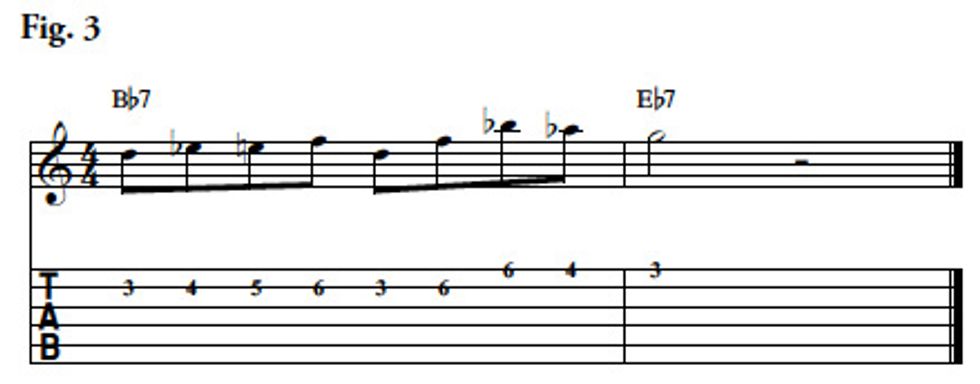When I hear great musicians solo over
a jazz-blues progression, I have the
feeling their lines and ideas are making the
chords change. It sounds like these players
are leading the way, rather than merely
reacting to the changing chords. To achieve
this, these savvy players often start and end
phrases with chord tones, and by doing so,
they define the harmony with their solo.
One way to jazz up your blues playing is
to focus on the mighty 3rd. Since a chord’s
3rd defines the harmony as either major or
minor, and this note is largely absent when
you improvise with a minor pentatonic
scale—the default choice for most guitarists
for blues solos—it’s a good place to start.
Here’s why: If you play only a minor pentatonic
scale over a typical jazz-blues progression,
the 3rd is missing when you solo over
the I chord, the IV chord, the #IV diminished,
the V chord, and even the VI, if you
take the common approach of playing that
chord as a dominant 7th. Starting an idea on
the 3rd does a lot to establish the harmony.
The following examples focus on Bb7 with
all the ideas starting on its 3rd, D. Each step
should be fairly easy. I recommend singing or
humming the ideas while you play them, as
this really helps to internalize the information
and puts it in your ear, as well as under your
fingers. Try as many rhythmic variations as
you can. After you have the idea under your
fingers, you’re ready to improvise freely over
a jazz-blues progression using the new idea
along with your current vocabulary. Only
move to the next step after you’ve mastered
the idea and can use it as your own.
To really focus on the essential part of this
concept, I set a few parameters for myself.
First, I start all my phrases on the 3rd.
Second, I want to play the root and 5th above
and below the 3rd when they’re in reach, and
finally, because we’re mostly working with
dominant 7th chords, I always play a b7th.
In Fig. 1 you can see how we can take these
rules and create some short melodic fragments
that work great over Bb7. Keep in mind that
just because a musical idea is simple, it doesn’t
take away how useful it can be. Set up a vamp
and then try working out these phrases in different
positions and octaves all over the neck. Download Example Audio 1...

A great way to expand on these ideas is to incorporate all four notes of the given 7th chord (root, 3rd, 5th, b7th) in your line, but still focus on starting with the 3rd. In the first two melodic fragments of Fig. 2, we add the 5th to the root and 3rd, and then work the notes of the entire arpeggio into the last two phrases. Download Example Audio 2...

Now we’re getting somewhere. The goal for any improviser is to connect the chords smoothly and create a melodic line that works. Sometimes that involves stepping out of diatonic harmony and adding some chromaticism. In Fig. 3, I’ve combined several ideas from the previous examples to create a line that moves from Bb7 (the I chord) to the Eb7 (the IV). Download Example Audio 3...

After you’re comfortable with the ideas over a Bb7, it’s time to start playing them through the changes of a typical jazz-blues structure. Take it slow and keep things simple. Listen to the music of Grant Green, Kenny Burrell, and Jim Hall to hear how motifs can be used not only in blues, but also other more complicated forms. With a little practice, you will be on your way to defining the harmony in your solos.
 Bret Boyer
Bret BoyerBased in Austin, Texas, Bret Boyer has been an active teacher and performer for more than 20 years. He has been a faculty member at several colleges and for the National Guitar Workshop. He’s made dozens of dollars from his CDs. His most recent recordings include Songs for Everyone and Hidden Constellation. bretboyer.com









![Rig Rundown: Russian Circles’ Mike Sullivan [2025]](https://www.premierguitar.com/media-library/youtube.jpg?id=62303631&width=1245&height=700&quality=70&coordinates=0%2C0%2C0%2C0)







